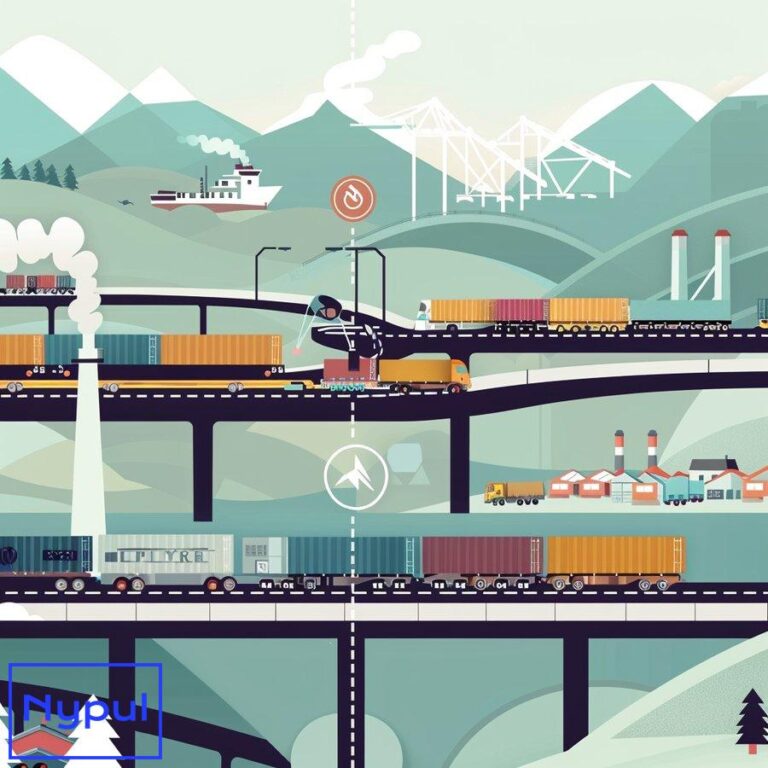What Is the Process of Finding the Most Cost Effective Route for Delivery of Goods
What factors influence cost-effective route planning?
Cost-effective route planning is a critical component of efficient logistics operations. Multiple factors come into play when determining the most economical delivery routes. Understanding these elements allows businesses to optimize their transportation networks and reduce operational expenses.
Distance and Fuel Consumption
The most obvious factor in route planning is the total distance traveled. Longer routes generally consume more fuel, increasing transportation costs. However, the relationship between distance and fuel usage is not always linear. Factors like road conditions, traffic patterns, and vehicle type can impact fuel efficiency.
For example, a shorter route through congested city streets may consume more fuel than a slightly longer highway route with steady traffic flow. Logistics planners must consider these nuances when mapping out delivery paths.
Time Constraints
Delivery time windows significantly impact route planning. Strict delivery schedules may necessitate faster but less fuel-efficient routes. Conversely, flexible delivery times allow for more optimized routing that prioritizes fuel economy over speed.
Time constraints also affect driver schedules and overtime costs. Routes that push drivers beyond regular working hours incur additional labor expenses. Balancing timely deliveries with labor costs is crucial for maintaining profitability.
Vehicle Capacity and Load Optimization
The capacity of delivery vehicles and how efficiently they are loaded directly influences routing decisions. Maximizing vehicle utilization reduces the number of trips required, lowering overall transportation costs.
Load optimization involves:
Strategic cargo arrangement: Placing heavier items at the bottom and distributing weight evenly improves fuel efficiency and vehicle stability.
Consolidation of shipments: Combining multiple deliveries into single trips reduces empty miles and improves overall efficiency.
Right-sizing vehicles: Matching vehicle size to typical load volumes prevents underutilization of larger trucks or overloading of smaller vehicles.
Traffic Patterns and Road Conditions
Real-time and historical traffic data play a crucial role in route optimization. Avoiding congested areas during peak hours can significantly reduce fuel consumption and delivery times. Similarly, considering road conditions such as construction zones, weight restrictions, and low bridges is essential for preventing delays and detours.
Seasonal weather patterns also influence routing decisions. Winter storms may necessitate alternate routes or additional time buffers, while summer heat waves could affect refrigerated cargo routing.
Regulatory Compliance
Transportation regulations impact route planning across various jurisdictions. Factors to consider include:
Hours of Service (HOS) rules: These limit the number of consecutive hours drivers can operate, affecting long-distance route planning.
Weight restrictions: Certain roads and bridges have vehicle weight limits, requiring alternate routes for heavy loads.
Emissions regulations: Low-emission zones in some cities may restrict access for certain vehicle types, necessitating route adjustments or fleet upgrades.
Customer Preferences and Service Levels
Customer-specific requirements often influence routing decisions. Some clients may have preferred delivery times or specific unloading procedures that impact scheduling. Additionally, different service levels (e.g., same-day, next-day, or standard shipping) require distinct routing strategies to meet varying time constraints.
Geographic Considerations
The physical geography of delivery areas plays a significant role in route planning. Factors include:
Urban vs. rural deliveries: Dense urban areas present challenges like limited parking and frequent stops, while rural routes may involve longer distances between deliveries.
Topography: Hilly or mountainous terrain affects fuel consumption and vehicle wear, potentially making flatter routes more cost-effective despite longer distances.
Natural barriers: Rivers, lakes, or mountain ranges may limit direct routing options, requiring strategic planning to minimize detours.
Cost Structure and Pricing Models
The way transportation costs are structured and priced influences routing decisions. For instance:
Fixed vs. variable costs: Routes that maximize the utilization of fixed costs (e.g., vehicle leases) may be prioritized over those that minimize variable costs (e.g., fuel).
Toll roads: The cost savings of toll roads must be weighed against their fees. In some cases, longer toll-free routes may be more economical.
Backhaul opportunities: Routes that allow for return cargo pickups can significantly improve overall cost-effectiveness by reducing empty miles.
Understanding and balancing these factors is crucial for developing cost-effective routing strategies. By considering the interplay between distance, time, vehicle utilization, regulatory compliance, and customer needs, logistics planners can create optimized delivery networks that minimize expenses while maintaining high service levels.
How can data analysis improve route optimization?

Data analysis plays a pivotal role in enhancing route optimization for logistics operations. By leveraging vast amounts of information from various sources, companies can make more informed decisions, predict potential issues, and continuously refine their delivery routes. This data-driven approach leads to significant improvements in efficiency, cost reduction, and customer satisfaction.
Historical Data Analysis
Analyzing historical delivery data provides valuable insights into patterns and trends that can inform future routing decisions. Key areas of focus include:
Delivery times: By examining past delivery performance, planners can identify consistent bottlenecks or delays in specific areas or during certain time periods.
Traffic patterns: Historical traffic data helps predict congestion levels at different times of day, allowing for more accurate route planning and scheduling.
Seasonal variations: Understanding how delivery patterns change throughout the year enables proactive adjustments to routing strategies during peak seasons or holiday periods.
Customer behavior: Analysis of past customer interactions, such as preferred delivery times or frequency of orders, allows for more personalized and efficient routing.
Real-time Data Integration
Incorporating real-time data into route optimization processes enables dynamic adjustments and improved responsiveness to changing conditions. Sources of real-time data include:
GPS tracking: Live location data from delivery vehicles allows for instant route adjustments based on current traffic conditions or unexpected delays.
Traffic updates: Integration with traffic monitoring systems provides up-to-the-minute information on road closures, accidents, or congestion.
Weather forecasts: Real-time weather data helps anticipate and avoid potential delays due to adverse conditions.
Customer notifications: Immediate feedback from customers regarding availability or changes in delivery preferences can be factored into route adjustments.
Predictive Analytics
Advanced data analysis techniques, including machine learning and artificial intelligence, enable predictive modeling for route optimization. These models can:
Forecast demand: By analyzing historical order data and external factors like promotions or events, companies can predict future delivery volumes and optimize routes accordingly.
Anticipate delays: Machine learning algorithms can identify patterns that lead to delays, allowing for preemptive route adjustments.
Optimize vehicle utilization: Predictive models can suggest the most efficient allocation of vehicles based on projected demand and capacity requirements.
Estimate delivery times: Advanced analytics can provide more accurate estimated time of arrival (ETA) predictions, improving customer communication and satisfaction.
Performance Metrics and KPI Analysis
Analyzing key performance indicators (KPIs) related to route efficiency helps identify areas for improvement and measure the impact of optimization efforts. Important metrics include:
On-time delivery rate: Tracking the percentage of deliveries made within the promised time window.
Cost per mile: Calculating the total cost of deliveries divided by the total miles driven.
Fuel efficiency: Monitoring fuel consumption across different routes and vehicles.
Driver productivity: Analyzing the number of successful deliveries per driver per shift.
Customer satisfaction scores: Correlating routing strategies with customer feedback to identify best practices.
| KPI | Description | Calculation Method |
|---|---|---|
| On-time Delivery Rate | Percentage of deliveries made within promised time window | (On-time Deliveries / Total Deliveries) x 100 |
| Cost per Mile | Total delivery costs divided by total miles driven | Total Delivery Costs / Total Miles Driven |
| Fuel Efficiency | Average fuel consumption per mile | Total Fuel Consumed / Total Miles Driven |
| Driver Productivity | Number of successful deliveries per driver per shift | Total Deliveries / (Number of Drivers x Number of Shifts) |
| Customer Satisfaction Score | Average rating from customer feedback | Sum of Customer Ratings / Number of Ratings |
Geospatial Analysis
Geospatial data analysis combines geographic information with other data sets to optimize routing decisions. This approach involves:
Heat mapping: Visualizing delivery density in different areas to identify high-demand zones and optimize resource allocation.
Cluster analysis: Grouping nearby delivery points to create more efficient multi-stop routes.
Territory planning: Using geospatial data to design balanced delivery territories that minimize overlap and maximize efficiency.
Accessibility analysis: Identifying areas with limited access or frequent delivery challenges to inform routing and scheduling decisions.
Network Analysis
Examining the entire transportation network as a system allows for holistic optimization. Network analysis techniques include:
Node optimization: Identifying the most efficient locations for distribution centers or transfer points within the network.
Flow analysis: Studying the movement of goods through the network to identify bottlenecks or underutilized routes.
Scenario modeling: Testing different network configurations to determine the most efficient overall structure for delivery operations.
Data-driven Decision Support Systems
Integrating data analysis into decision support systems provides route planners with powerful tools for optimization. These systems can:
Automate route planning: Use algorithms to generate optimized routes based on multiple data inputs and constraints.
Provide real-time recommendations: Suggest route adjustments as conditions change throughout the day.
Simulate scenarios: Allow planners to test the impact of different routing strategies before implementation.
Generate comprehensive reports: Produce detailed analytics on route performance, cost savings, and areas for improvement.
Continuous Improvement through Machine Learning
Machine learning algorithms can continuously analyze routing data to identify patterns and improve optimization over time. This ongoing process involves:
Adaptive routing: Algorithms that learn from past performance to refine future routing decisions.
Anomaly detection: Identifying unusual patterns or outliers that may indicate issues in the routing process.
Feedback loops: Incorporating driver and customer feedback into the optimization process to address qualitative factors.
By leveraging these data analysis techniques, logistics companies can significantly enhance their route optimization processes. The combination of historical insights, real-time data integration, predictive modeling, and continuous learning enables more efficient, cost-effective, and responsive delivery operations. As data collection and analysis capabilities continue to advance, the potential for further optimization in route planning will only grow, driving ongoing improvements in logistics performance.
Which technologies are essential for efficient route planning?
Efficient route planning relies on a combination of advanced technologies that work together to optimize delivery operations. These technologies enable logistics companies to process vast amounts of data, make real-time decisions, and continuously improve their routing strategies. Understanding the essential technologies for route planning is crucial for businesses looking to enhance their logistics efficiency.

Global Positioning System (GPS) Technology
GPS technology forms the backbone of modern route planning systems. It provides real-time location data for vehicles and enables accurate tracking of deliveries. Key applications include:
Vehicle tracking: Real-time monitoring of delivery vehicle locations allows for dynamic route adjustments and improved estimated time of arrival (ETA) calculations.
Navigation: Turn-by-turn directions guide drivers along optimized routes, reducing the likelihood of wrong turns or missed deliveries.
Geofencing: Creating virtual boundaries around specific locations triggers automated actions, such as notifications when a vehicle enters or leaves a designated area.
Geographic Information Systems (GIS)
GIS technology integrates various types of geographical data to create comprehensive maps and spatial analyses. In route planning, GIS is used for:
Spatial analysis: Identifying optimal delivery zones and territories based on geographic factors and customer distribution.
Route visualization: Creating visual representations of planned routes to help drivers and dispatchers understand and optimize delivery paths.
Address validation: Ensuring accurate and standardized address information to prevent delivery errors and improve routing efficiency.
Artificial Intelligence (AI) and Machine Learning (ML)
AI and ML technologies are revolutionizing route planning by enabling systems to learn from past data and make intelligent predictions. Applications include:
Predictive analytics: Forecasting delivery demand, traffic patterns, and potential delays to optimize route planning proactively.
Dynamic routing: Continuously adjusting routes based on real-time conditions and learned patterns to maximize efficiency.
Anomaly detection: Identifying unusual events or patterns that may impact routing decisions and require immediate attention.
Internet of Things (IoT)
IoT devices collect and transmit data from various points in the delivery process, providing valuable insights for route planning. Key IoT applications include:
Vehicle telematics: Monitoring vehicle performance, fuel consumption, and driver behavior to optimize routing and maintenance schedules.
Environmental sensors: Tracking temperature, humidity, and other conditions for sensitive cargo to ensure proper handling and routing.
Smart traffic systems: Integrating with city-wide IoT networks to receive real-time traffic and road condition updates.
Cloud Computing
Cloud-based systems provide the necessary computational power and storage capacity for processing large volumes of routing data. Benefits include:
Scalability: Easily adjusting computing resources to handle peak demand periods without significant infrastructure investments.
Real-time data processing: Enabling instant updates and route optimizations based on current conditions.
Collaborative planning: Allowing multiple stakeholders to access and contribute to route planning from different locations.
Mobile Technologies
Mobile devices and applications play a crucial role in modern route planning by providing real-time communication and data collection capabilities. Key features include:
Driver apps: Providing drivers with up-to-date route information, delivery instructions, and communication tools.
Customer notifications: Sending automated updates to customers about delivery status and ETAs.
Proof of delivery: Capturing electronic signatures and photos to confirm successful deliveries and update route status in real-time.
Big Data Analytics Platforms
Big data technologies enable the processing and analysis of vast amounts of routing-related data from multiple sources. These platforms are used for:
Historical data analysis: Identifying long-term trends and patterns to inform strategic routing decisions.
Performance optimization: Analyzing key performance indicators (KPIs) to continuously refine routing strategies.
Scenario modeling: Testing different routing scenarios to identify the most efficient approaches for various conditions.
Application Programming Interfaces (APIs)
APIs enable seamless integration between different software systems and data sources, which is crucial for comprehensive route planning. Common API integrations include:
Traffic data APIs: Accessing real-time traffic information from external providers to inform routing decisions.
Weather APIs: Incorporating weather forecasts and alerts into route planning to avoid potential delays or hazards.
Customer relationship management (CRM) APIs: Integrating customer data and preferences into the routing process for personalized delivery experiences.
Optimization Algorithms
Sophisticated algorithms form the core of route optimization software, processing multiple variables to determine the most efficient delivery paths. Key types include:
Vehicle Routing Problem (VRP) algorithms: Solving complex multi-stop routing challenges while considering various constraints.
Traveling Salesman Problem (TSP) algorithms: Optimizing single-vehicle routes for the shortest overall distance.
Genetic algorithms: Using evolutionary computation techniques to generate and refine routing solutions over time.
Digital Twin Technology
Digital twin technology creates virtual representations of physical logistics networks, enabling advanced simulation and optimization. Applications include:
Network modeling: Creating detailed digital models of entire delivery networks to test and optimize routing strategies.
What-if analysis: Simulating the impact of changes in routing parameters or network structure before implementation.
Real-time optimization: Continuously updating the digital twin with live data to provide ongoing route refinements.
| Technology | Primary Function | Key Benefits for Route Planning |
|---|---|---|
| GPS | Real-time location tracking | Accurate vehicle positioning, dynamic routing |
| GIS | Spatial data integration | Comprehensive mapping, territory optimization |
| AI/ML | Predictive analytics, learning | Adaptive routing, pattern recognition |
| IoT | Data collection from multiple sources | Real-time vehicle and cargo monitoring |
| Cloud Computing | Scalable data processing | Real-time optimization, collaborative planning |
| Mobile Tech | On-the-go communication | Driver guidance, customer updates |
| Big Data Analytics | Large-scale data processing | Trend analysis, performance optimization |
| APIs | System integration | Seamless data exchange, enhanced functionality |
| Optimization Algorithms | Complex problem-solving | Efficient multi-stop routing |
| Digital Twin | Virtual network simulation | Advanced scenario testing, continuous optimization |
These technologies work in concert to create powerful route planning systems. GPS and IoT devices collect real-time data, which is processed using cloud computing and big data analytics platforms. AI and ML algorithms then analyze this information to make intelligent routing decisions, while GIS technology provides the spatial context for these optimizations. Mobile technologies ensure that drivers and customers stay informed throughout the delivery process, and APIs enable seamless integration with other business systems.
The key to successful implementation lies in selecting the right combination of technologies that align with a company’s specific needs and scale of operations. Smaller businesses may start with basic GPS tracking and mobile apps, while larger enterprises might invest in comprehensive digital twin systems and advanced AI-driven optimization platforms.
As these technologies continue to evolve, they will offer even greater opportunities for route planning optimization. Future developments may include increased use of autonomous vehicles, enhanced predictive capabilities through advanced AI, and more sophisticated integration with smart city infrastructure. Companies that stay abreast of these technological advancements and effectively incorporate them into their route planning processes will be well-positioned to achieve significant competitive advantages in the logistics industry.
How do multiple variables affect delivery route decisions?
Delivery route decisions are influenced by a complex interplay of multiple variables, each contributing to the overall efficiency and effectiveness of the logistics operation. Understanding how these variables interact and impact routing choices is crucial for optimizing delivery networks and maintaining high levels of service while controlling costs.

Time Windows and Delivery Priorities
Time constraints significantly impact route planning, often serving as primary drivers in decision-making processes.
Strict deliverywindows: Customers with specific delivery time requirements necessitate prioritization in route planning, potentially leading to less efficient overall routes to meet these commitments.
Service level agreements (SLAs): Different service levels (e.g., same-day, next-day, standard) require distinct routing strategies to balance speed and efficiency.
Time-sensitive cargo: Perishable goods or urgent deliveries may need to be prioritized over other shipments, affecting the overall route structure.
Vehicle Capacity and Load Characteristics
The physical attributes of the cargo and the vehicles used for transport play a crucial role in route planning.
Vehicle size and weight limits: Different vehicle types have varying capacities, affecting the number of stops possible on a single route.
Cargo dimensions: Bulky or oddly-shaped items may limit the total number of deliveries per trip, requiring more frequent returns to the distribution center.
Weight distribution: Proper load balancing is essential for vehicle stability and fuel efficiency, influencing the order of deliveries on a route.
Special handling requirements: Temperature-controlled goods or hazardous materials may necessitate specific routing to ensure proper handling and regulatory compliance.
Geographic and Environmental Factors
The physical landscape and environmental conditions of the delivery area significantly impact route decisions.
Urban vs. rural deliveries: Dense urban areas present challenges like traffic congestion and limited parking, while rural routes may involve longer distances between stops.
Topography: Hilly terrain can affect fuel consumption and vehicle wear, potentially making flatter routes more cost-effective despite longer distances.
Weather conditions: Severe weather may necessitate alternative routes or additional time buffers to ensure safe and timely deliveries.
Seasonal variations: Tourist seasons or agricultural harvest periods can dramatically change traffic patterns and delivery volumes in certain areas.
Traffic Patterns and Road Conditions
Real-time and historical traffic data are critical variables in route optimization.
Rush hour congestion: Avoiding peak traffic times on major routes can significantly reduce delivery times and fuel consumption.
Construction zones: Ongoing roadwork may require temporary route adjustments to maintain efficiency.
Accident hotspots: Areas prone to frequent accidents may be avoided or approached with caution in route planning.
Road quality: Routes with better-maintained roads may be preferred to reduce vehicle wear and tear, even if slightly longer.
Driver Considerations
The human element in delivery operations introduces several variables that affect routing decisions.
Hours of Service (HOS) regulations: Legal limits on driving time require careful planning to ensure compliance while maximizing efficiency.
Driver familiarity: Routes may be adjusted to leverage drivers’ knowledge of specific areas or customer locations.
Break and rest periods: Incorporating mandatory rest stops into routes is essential for driver well-being and regulatory compliance.
Skill levels: Matching driver skills with route complexity ensures efficient and safe deliveries, particularly for specialized cargo or challenging delivery locations.
Customer-Specific Requirements
Individual customer needs and preferences add another layer of complexity to route planning.
Delivery preferences: Some customers may have specific requirements for delivery times or procedures that must be accommodated.
Access restrictions: Gated communities, secure facilities, or locations with limited delivery hours require special consideration in routing.
Regular vs. occasional customers: Routes may be structured to prioritize regular customers or to efficiently incorporate occasional deliveries.
Returns and pickups: Integrating return shipments or pickup requests into existing delivery routes can improve overall efficiency but adds complexity to planning.
Cost Considerations
Financial factors play a significant role in shaping optimal delivery routes.
Fuel costs: Routes may be adjusted to minimize fuel consumption, which can vary based on vehicle type, load, and terrain.
Toll roads: The potential time savings of toll roads must be weighed against their costs when determining the most cost-effective routes.
Overtime pay: Routes should be designed to minimize overtime hours while still meeting delivery commitments.
Vehicle maintenance: Balancing route efficiency with vehicle wear and tear is crucial for long-term cost management.
Regulatory and Legal Constraints
Various regulations and legal requirements impact route planning across different jurisdictions.
Vehicle weight restrictions: Certain roads or bridges may have weight limits that restrict access for larger delivery vehicles.
Low emission zones: Some urban areas impose restrictions on vehicle types, requiring route adjustments or fleet modifications.
Local delivery time restrictions: Noise ordinances or traffic regulations may limit delivery times in residential areas.
Cross-border regulations: International deliveries must account for customs procedures and varying transportation laws.
Technology and Data Availability
The technological capabilities of the logistics operation influence the complexity and sophistication of route planning.
Real-time tracking systems: Advanced GPS and telematics allow for dynamic route adjustments based on current conditions.
Historical data analysis: The ability to process and learn from past delivery data enables more accurate predictions and optimizations.
Integration with external data sources: Access to real-time traffic, weather, and event data allows for more responsive route planning.
Optimization software capabilities: The sophistication of routing algorithms determines how effectively multiple variables can be balanced in route decisions.
Network Considerations
The structure of the overall logistics network impacts individual route decisions.
Distribution center locations: The placement of warehouses and distribution hubs influences the starting and ending points of delivery routes.
Multi-echelon networks: Complex supply chains with multiple tiers of distribution require coordinated routing across different levels.
Backhaul opportunities: Routes may be designed to incorporate pickup opportunities on return trips, improving overall network efficiency.
Intermodal connections: For longer-distance deliveries, routes may need to account for transfers between different modes of transportation.
Balancing these multiple variables requires sophisticated optimization algorithms and decision-making processes. The relative importance of each factor may vary depending on the specific context of the delivery operation, such as the industry sector, geographic region, or business model.
To effectively manage these variables, logistics planners often employ a hierarchical decision-making approach:
- Strategic level: Long-term decisions about network structure, facility locations, and fleet composition.
- Tactical level: Medium-term planning for resource allocation, territory design, and service level definitions.
- Operational level: Day-to-day route optimization and scheduling based on current conditions and immediate requirements.
At each level, planners must consider the interplay between different variables and make trade-offs to achieve the best overall outcomes. For example, a route that minimizes distance may not be optimal if it leads to missed time windows or requires overtime pay for drivers.
Advanced route optimization systems use machine learning and artificial intelligence to continuously analyze the impact of these variables on delivery performance. By processing vast amounts of historical and real-time data, these systems can identify patterns and relationships between variables that may not be immediately apparent to human planners.
As logistics operations become increasingly complex and customer expectations for fast, flexible delivery continue to rise, the ability to effectively manage and optimize across multiple variables will be a key differentiator for successful delivery businesses. Companies that invest in advanced analytics capabilities and develop a deep understanding of how these variables interact will be better positioned to create efficient, cost-effective delivery routes that meet the diverse needs of their customers while maintaining operational excellence.
What are the key strategies for implementing dynamic routing?
Dynamic routing represents a significant advancement in logistics management, offering the flexibility to adapt delivery routes in real-time based on changing conditions. Implementing dynamic routing effectively requires a strategic approach that leverages technology, data, and operational processes. Here are the key strategies for successfully implementing dynamic routing in a logistics operation:
Invest in Real-Time Data Collection and Processing
The foundation of dynamic routing is the ability to gather and analyze data in real-time. This requires:
GPS tracking: Implementing advanced GPS systems in all delivery vehicles to provide continuous location updates.
IoT sensors: Deploying sensors to monitor vehicle conditions, traffic, weather, and other relevant factors affecting deliveries.
Data integration platforms: Developing systems that can aggregate and process data from multiple sources quickly and efficiently.
Develop Advanced Optimization Algorithms
To make effective use of real-time data, companies need sophisticated algorithms capable of rapid route recalculation. This involves:
Machine learning models: Implementing AI-driven algorithms that can learn from historical data and improve routing decisions over time.
Multi-variable optimization: Designing algorithms that can balance multiple factors such as time, distance, fuel efficiency, and customer priorities.
Scalable computing infrastructure: Ensuring sufficient processing power to handle complex calculations for large fleets in real-time.
Implement Flexible Delivery Scheduling
Dynamic routing requires a shift away from rigid delivery schedules. Strategies include:
Time window optimization: Offering customers flexible delivery windows that allow for route adjustments.
Priority-based scheduling: Implementing systems that can automatically prioritize deliveries based on urgency, customer importance, or other factors.
Dynamic appointment booking: Allowing customers to book or modify delivery times through user-friendly interfaces that integrate with the routing system.
Enhance Driver Communication and Support
Effective dynamic routing relies heavily on driver cooperation and adaptability. Key strategies include:
Mobile app integration: Providing drivers with user-friendly mobile applications that offer real-time route updates and communication channels.
Training programs: Developing comprehensive training to help drivers understand and effectively use dynamic routing systems.
Performance incentives: Implementing reward systems that encourage drivers to follow optimized routes and adapt to changes efficiently.
Optimize Fleet Management
Dynamic routing often requires a more flexible approach to fleet management:
Diverse vehicle fleet: Maintaining a mix of vehicle types to handle varying delivery requirements and route conditions.
Predictive maintenance: Implementing systems that can forecast vehicle maintenance needs to prevent breakdowns and ensure vehicle availability.
Capacity utilization optimization: Using dynamic routing to maximize vehicle capacity utilization, potentially reducing the overall fleet size.
Integrate with Customer Relationship Management (CRM) Systems
Linking dynamic routing with CRM systems enhances the ability to meet customer needs:
Preference-based routing: Incorporating customer preferences and historical data into routing decisions.
Proactive communication: Implementing systems that automatically notify customers of delivery status changes or ETAs.
Feedback integration: Collecting and analyzing customer feedback to continuously improve routing strategies.
Develop Robust Contingency Planning
Dynamic routing systems must be able to handle unexpected events effectively:
Scenario modeling: Creating and testing response plans for various disruptions such as traffic incidents, weather events, or vehicle breakdowns.
Automatic rerouting triggers: Implementing systems that can automatically initiate rerouting based on predefined criteria or thresholds.
Manual override capabilities: Providing dispatchers with tools to manually adjust routes when necessary, overriding automated systems.
Implement Continuous Improvement Processes
To maximize the benefits of dynamic routing, organizations should:
Performance analytics: Regularly analyze routing performance data to identify trends, bottlenecks, and improvement opportunities.
A/B testing: Conduct controlled experiments to test different routing strategies and algorithms.
Feedback loops: Establish processes for collecting and incorporating feedback from drivers, customers, and other stakeholders into system improvements.
Ensure Regulatory Compliance and Ethical Considerations
As routing becomes more dynamic, it’s crucial to maintain compliance with regulations and ethical standards:
Data privacy measures: Implementing robust data protection systems to safeguard customer and driver information.
Fairness in routing: Ensuring that dynamic routing algorithms do not unfairly disadvantage certain customers or areas.
Compliance monitoring: Integrating regulatory requirements (e.g., driver hours, vehicle weight limits) into the routing system to ensure automatic compliance.
Foster a Culture of Adaptability
Successfully implementing dynamic routing often requires organizational change:
Change management programs: Developing comprehensive plans to help staff at all levels adapt to more flexible and dynamic operations.
Cross-functional collaboration: Encouraging cooperation between departments (e.g., IT, operations, customer service) to support dynamic routing initiatives.
Continuous learning initiatives: Providing ongoing training and development opportunities to keep staff updated on evolving routing technologies and best practices.
Leverage Predictive Analytics
While dynamic routing focuses on real-time adjustments, incorporating predictive elements can enhance its effectiveness:
Demand forecasting: Using historical data and external factors to predict delivery volumes and patterns, allowing for proactive route planning.
Traffic prediction: Integrating advanced traffic forecasting models to anticipate congestion before it occurs.
Weather impact analysis: Incorporating weather forecasts to predict and mitigate potential disruptions to delivery routes.
Implement Multi-Echelon Routing Strategies
For complex supply chains, dynamic routing should consider multiple levels of distribution:
Integrated planning: Developing systems that can optimize routes across different stages of the supply chain simultaneously.
Transfer point optimization: Dynamically adjusting the use of intermediate transfer points or cross-docking facilities based on current conditions.
Last-mile flexibility: Implementing strategies that allow for rapid adjustments in the final delivery stage, where variability is often highest.
Develop Partnerships and Collaborations
Enhancing dynamic routing capabilities through strategic partnerships:
Data sharing agreements: Collaborating with other logistics providers or local authorities to share relevant data for improved routing decisions.
Technology partnerships: Working with software vendors and tech companies to develop cutting-edge routing solutions tailored to specific needs.
Academic collaborations: Partnering with universities or research institutions to explore innovative routing algorithms and strategies.
Implementing these strategies requires a significant investment in technology, processes, and people. However, the potential benefits of dynamic routing are substantial, including improved customer satisfaction, reduced operational costs, and increased overall efficiency of logistics operations.
Success in dynamic routing implementation often comes from a phased approach, starting with pilot programs and gradually expanding capabilities. This allows organizations to learn from early experiences, refine their systems, and build the necessary organizational capabilities over time.
As technology continues to evolve, new opportunities for enhancing dynamic routing will emerge. Advancements in areas such as autonomous vehicles, drone deliveries, and edge computing are likely to further revolutionize the field of dynamic routing in the coming years. Organizations that establish a strong foundation in dynamic routing now will be well-positioned to leverage these future innovations and maintain a competitive edge in the rapidly evolving logistics landscape.
How can companies evaluate and refine their delivery routes?
Evaluating and refining delivery routes is a critical process for logistics companies seeking to optimize their operations, reduce costs, and improve customer satisfaction. This ongoing effort requires a systematic approach that combines data analysis, performance measurement, and continuous improvement strategies. Here’s a comprehensive guide on how companies can effectively evaluate and refine their delivery routes:
Establish Clear Performance Metrics

The first step in evaluating delivery routes is to define and track relevant key performance indicators (KPIs). These metrics provide a quantitative basis for assessing route efficiency and identifying areas for improvement.
On-time delivery rate: Measures the percentage of deliveries made within the promised time window.
Cost per mile: Calculates the total cost of deliveries divided by the total miles driven.
Fuel efficiency: Tracks fuel consumption across different routes and vehicles.
Driver productivity: Analyzes the number of successful deliveries per driver per shift.
Customer satisfaction scores: Correlates routing strategies with customer feedback.
Vehicle utilization: Measures how effectively the cargo capacity of each vehicle is used.
Route density: Evaluates the number of stops or deliveries made within a given geographic area.
Implement Comprehensive Data Collection
Gathering accurate and comprehensive data is crucial for meaningful route evaluation. Companies should focus on:
GPS tracking data: Collect detailed information on vehicle movements, including speed, stops, and idle times.
Delivery confirmation data: Record precise delivery times, locations, and any issues encountered during deliveries.
Customer feedback: Systematically gather and analyze customer comments and satisfaction ratings.
Driver input: Collect insights and observations from drivers about route challenges and opportunities for improvement.
Environmental data: Incorporate information on weather conditions, traffic patterns, and road quality that may affect route performance.
Conduct Regular Route Audits
Periodic, in-depth examinations of existing routes can reveal inefficiencies and opportunities for optimization:
Visual route mapping: Use GIS tools to visually analyze route patterns and identify potential overlaps or inefficiencies.
Time-motion studies: Conduct detailed analyses of driver activities to identify time-consuming processes or unnecessary steps.
Ride-alongs: Have route planners or managers accompany drivers to gain firsthand insights into route challenges and opportunities.
Historical performance review: Analyze long-term trends in route performance to identify seasonal patterns or gradual changes in efficiency.
Leverage Advanced Analytics
Modern data analytics tools can uncover insights that may not be apparent through manual analysis:
Predictive modeling: Use historical data to forecast future delivery volumes and optimize routes proactively.
Pattern recognition: Employ machine learning algorithms to identify recurring issues or opportunities across multiple routes.
Scenario analysis: Simulate different routing strategies to predict their impact on key performance metrics.
Anomaly detection: Automatically identify unusual patterns or outliers that may indicate problems or opportunities for improvement.
Implement A/B Testing
Systematically test alternative routing strategies to identify improvements:
Controlled experiments: Implement different routing approaches on similar routes and compare performance outcomes.
Gradual rollouts: Introduce new routing strategies in phases, allowing for comparison with existing methods and fine-tuning before full implementation.
Multi-variable testing: Experiment with changing multiple route parameters simultaneously to identify optimal combinations.
Utilize Customer Feedback
Incorporate customer perspectives into route evaluation and refinement:
Satisfaction surveys: Regularly collect and analyze customer feedback on delivery experiences.
Preference analysis: Study customer preferences for delivery times and methods to inform routing strategies.
Complaint patterns: Identify recurring issues or areas of dissatisfaction that may be related to routing decisions.
Collaborative improvement: Engage key customers in discussions about how to enhance delivery processes and routes.
Optimize for Last-Mile Efficiency
The last mile of delivery often presents the greatest challenges and opportunities for optimization:
Cluster analysis: Group nearby delivery points to create more efficient multi-stop routes.
Dynamic dispatch: Implement systems that can assign deliveries to drivers in real-time based on current locations and conditions.
Alternative delivery methods: Evaluate the use of lockers, collection points, or crowdsourced delivery options for challenging locations.
Micro-hub strategies: Consider establishing small, local distribution points to improve last-mile efficiency in dense urban areas.
Conduct Competitive Benchmarking
Compare route performance against industry standards and competitors:
Industry reports: Analyze published data on industry-wide delivery performance metrics.
Mystery shopping: Use third-party services to assess competitor delivery experiences and compare them to your own.
Technology adoption: Stay informed about routing technologies and strategies employed by industry leaders.
Collaborative benchmarking: Participate in industry groups or associations that share non-sensitive performance data.
Integrate Driver Feedback
Drivers often have valuable insights that can inform route refinement:
Regular debriefings: Conduct structured feedback sessions with drivers to gather observations and suggestions.
Driver surveys: Implement periodic surveys to collect driver opinions on route efficiency and challenges.
Incentive programs: Develop reward systems that encourage drivers to suggest route improvements.
Driver-dispatcher collaboration: Foster open communication channels between drivers and route planners.
Leverage Telematics Data
Advanced vehicle telematics systems provide rich data for route evaluation:
Idle time analysis: Identify areas where vehicles spend excessive time idling, indicating potential route inefficiencies.
Speed pattern analysis: Evaluate vehicle speed data to optimize routes for fuel efficiency and safety.
Harsh event monitoring: Analyze data on harsh braking or acceleration to identify problematic route segments.
Vehicle health monitoring: Use maintenance data to ensure routes are designed with vehicle longevity in mind.
Implement Continuous Improvement Processes
Establish systematic approaches to ongoing route refinement:
Regular review cycles: Schedule periodic route evaluations at set intervals (e.g., monthly, quarterly).
Improvement teams: Form cross-functional teams dedicated to analyzing and enhancing routing strategies.
PDCA (Plan-Do-Check-Act) cycles: Apply structured problem-solving methodologies to address identified route issues.
Knowledge management: Develop systems to capture and share best practices and lessons learned across the organization.
Utilize Advanced Optimization Software
Leverage state-of-the-art routing optimization tools:
AI-powered route planning: Implement machine learning algorithms that can process multiple variables to suggest optimal routes.
Real-time optimization: Use systems capable of dynamically adjusting routes based on current conditions.
What-if analysis tools: Employ software that allows planners to model the impact of potential route changes before implementation.
Integration with ERP systems: Ensure routing software is fully integrated with other business systems for comprehensive optimization.
Consider Environmental Impact
Incorporate sustainability metrics into route evaluation:
Carbon footprint calculation: Measure and track the environmental impact of different routing strategies.
Green vehicle integration: Evaluate how the use of electric or alternative fuel vehicles affects route planning and efficiency.
Emissions reduction strategies: Develop routing approaches that minimize overall emissions while maintaining service levels.
Compliance with environmental regulations: Ensure routes are designed to adhere to current and anticipated environmental laws.
Assess Network Design Impact
Recognize that route optimization is closely tied to overall network design:
Distribution center placement: Evaluate how the location of warehouses and distribution centers affects route efficiency.
Territory design: Regularly reassess delivery territories to ensure they remain balanced and efficient.
Multi-echelon optimization: Consider how changes in one part of the supply chain impact routing in other areas.
Cross-docking opportunities: Assess whether incorporating cross-docking facilities could improve overall route efficiency.
By implementing these strategies for evaluating and refining delivery routes, companies can achieve significant improvements in operational efficiency, cost reduction, and customer satisfaction. The key to success lies in adopting a data-driven, systematic approach that combines technological solutions with human insights and a commitment to continuous improvement.
It’s important to note that route optimization is an ongoing process. As business conditions, customer expectations, and technologies evolve, so too must routing strategies. Companies that establish robust evaluation and refinement processes will be well-positioned to adapt to changing market conditions and maintain a competitive edge in the dynamic field of logistics and delivery services.
Moreover, as the logistics industry continues to advance, new opportunities for route optimization will emerge. Future developments in areas such as autonomous vehicles, drone deliveries, and advanced AI may revolutionize how routes are planned and executed. Companies that have established strong foundations in route evaluation and refinement will be better prepared to leverage these innovations and stay ahead in an increasingly competitive marketplace.
What are the unique challenges of last-mile delivery optimization?
Last-mile delivery, the final step in the supply chain where products are transported from a distribution center to the end customer, presents a unique set of challenges for logistics optimization. These challenges are often the most complex and costly to address, making last-mile delivery a critical focus area for companies seeking to improve their overall logistics efficiency.
High Costs
Last-mile delivery is typically the most expensive part of the shipping process, often accounting for up to 53% of the total shipping cost.
Inefficient stop density: In urban areas, multiple stops in close proximity can lead to frequent starts and stops, increasing fuel consumption and wear on vehicles.
Low drop sizes: Delivering small packages to individual consumers is less efficient than bulk deliveries to businesses.
Failed deliveries: When customers are not available to receive packages, the cost of re-delivery or return shipping can be substantial.
Unpredictable Urban Environments
Cities present a complex landscape for delivery operations, with numerous variables affecting efficiency.
Traffic congestion: Varying traffic patterns throughout the day can significantly impact delivery times and route planning.
Parking challenges: Limited parking in urban areas can force drivers to circle blocks or park illegally, leading to delays and potential fines.
Access restrictions: Gated communities, secure buildings, or areas with time-based delivery restrictions complicate route planning and execution.
Diverse Delivery Locations
The variety of delivery destinations in last-mile logistics adds complexity to route optimization.
Residential vs. commercial deliveries: Different types of locations may have varying receiving procedures and time windows.
Rural deliveries: Long distances between stops in rural areas can significantly increase delivery costs and time.
Multi-unit buildings: Apartment complexes and office buildings may require additional time for security procedures or locating specific units.
Customer Expectations
Modern consumers have high expectations for delivery speed and flexibility, putting pressure on last-mile operations.
Same-day and on-demand delivery: Meeting rapid delivery timeframes requires sophisticated routing and resource allocation.
Delivery time windows: Offering narrow delivery windows to accommodate customer schedules increases routing complexity.
Real-time tracking: Providing accurate, up-to-the-minute delivery status updates requires advanced tracking and communication systems.
Variable Demand
Fluctuations in order volumes can make it challenging to maintain consistent delivery efficiency.
Seasonal peaks: Holiday seasons or promotional events can lead to sudden spikes in delivery demand.
Day-of-week variations: Order volumes often vary significantly between weekdays and weekends.
Weather impacts: Adverse weather conditions can both increase delivery demand and complicate route execution.
Environmental Concerns
Growing awareness of environmental issues puts pressure on companies to reduce the ecological impact of last-mile delivery.
Emissions reduction: Balancing the need for rapid delivery with efforts to minimize carbon footprint presents a significant challenge.
Sustainable packaging: Implementing eco-friendly packaging solutions while ensuring product protection adds complexity to the delivery process.
Noise pollution: In urban areas, there’s increasing pressure to reduce noise from delivery vehicles, potentially limiting delivery hours or vehicle types.
Technology Integration
While technology offers solutions to many last-mile challenges, its implementation comes with its own set of difficulties.
Data silos: Integrating data from multiple systems (e.g., order management, route planning, GPS tracking) can be technically challenging.
Real-time optimization: Implementing systems capable of dynamically adjusting routes based on current conditions requires significant computational power and sophisticated algorithms.
User adoption: Ensuring that drivers and dispatchers effectively use new technologies often requires comprehensive training and change management.
Security and Privacy
Protecting sensitive information in last-mile operations is crucial but challenging.
Customer data protection: Safeguarding delivery addresses and personal information requires robust security measures.
Preventing package theft: Developing secure delivery methods to combat “porch piracy” adds complexity to the delivery process.
Driver privacy: Balancing the need for route tracking with respect for driver privacy can be a delicate issue.
Workforce Management
The human element in last-mile delivery presents unique optimization challenges.
Driver retention: High turnover rates in delivery driver positions can lead to increased training costs and reduced efficiency.
Gig economy integration: Incorporating freelance or crowdsourced drivers into delivery operations adds complexity to workforce management and quality control.
Skill variability: Differences in driver experience and familiarity with delivery areas can impact route efficiency.
Regulatory Compliance
Navigating the complex regulatory landscape surrounding last-mile delivery can be challenging.
Local regulations: Varying rules on parking, delivery hours, and vehicle types across different municipalities complicate route planning.
Labor laws: Ensuring compliance with driver work hour regulations while maintaining delivery efficiency requires careful scheduling.
Customs and duties: For international last-mile deliveries, managing customs clearance and duty payments adds another layer of complexity.
Returns Management
Efficiently handling product returns is a growing challenge in last-mile logistics.
Reverse logistics: Integrating return pickups into existing delivery routes without compromising efficiency is complex.
Processing speed: Meeting customer expectations for quick refunds requires streamlined return processes.
Quality control: Assessing returned items quickly and accurately to determine resale potential adds to operational complexity.
To address these unique challenges of last-mile delivery optimization, companies are employing a variety of innovative strategies:
Advanced Route Optimization Software
Implementing AI-driven routing systems that can process multiple variables in real-time to create the most efficient delivery paths.
Alternative Delivery Methods
Exploring options like parcel lockers, retail pickup points, and autonomous delivery vehicles to reduce the complexities of direct-to-consumer delivery.
Micro-Fulfillment Centers
Establishing small, local distribution hubs to reduce the distance for last-mile deliveries in urban areas.
Predictive Analytics
Using historical data and machine learning to forecast demand patterns and optimize resource allocation.
Sustainable Vehicle Fleets
Investing in electric or alternative fuel vehicles to address environmental concerns while potentially gaining access to restricted urban areas.
Crowdsourced Delivery
Leveraging gig economy platforms to handle demand spikes and reduce fixed costs associated with maintaining a large delivery fleet.
Customer Communication Platforms
Implementing systems that provide real-time delivery updates and allow for easy rescheduling to reduce failed deliveries.
IoT and Telematics
Using Internet of Things devices and advanced telematics to gather real-time data on vehicle and package status for improved tracking and optimization.
Dynamic Pricing Models
Implementing flexible pricing strategies that incentivize customers to choose delivery options that improve overall route efficiency.
Collaborative Logistics
Partnering with other retailers or logistics providers to consolidate deliveries and improve route density.
Blockchain Technology
Exploring blockchain solutions for improved transparency, security, and efficiency in tracking and managing last-mile deliveries.
Drone Delivery
Investigating the potential of drone technology for rapid, direct deliveries, particularly in hard-to-reach areas.
As e-commerce continues to grow and consumer expectations evolve, the challenges of last-mile delivery optimization will remain at the forefront of logistics innovation. Companies that can effectively address these challenges through a combination of technology, strategic planning, and operational excellence will be well-positioned to succeed in the competitive landscape of modern logistics.
The future of last-mile delivery is likely to see continued innovation, with emerging technologies like autonomous vehicles, artificial intelligence, and the Internet of Things playing increasingly significant roles. However, the fundamental challenge will remain balancing the often-competing demands of cost efficiency, speed, flexibility, and sustainability in the complex environment of final product delivery to the end customer.
How can businesses overcome common routing obstacles?
Businesses face numerous routing obstacles in their logistics operations, ranging from traffic congestion to unexpected delays and changing customer demands. Overcoming these challenges requires a combination of strategic planning, technological solutions, and operational flexibility. Here’s a comprehensive guide on how businesses can effectively tackle common routing obstacles:
Traffic Congestion and Unpredictable Travel Times
Urban congestion and variable travel times are among the most persistent routing challenges.
Real-time traffic data integration: Implement routing systems that incorporate live traffic updates to dynamically adjust routes.
Historical traffic pattern analysis: Use big data analytics to identify recurring congestion patterns and plan routes accordingly.
Time-based routing: Adjust delivery schedules to avoid peak traffic hours when possible.
Alternative transportation modes: Consider using bicycles or electric scooters for short-distance deliveries in congested areas.
Weather-Related Disruptions
Adverse weather conditions can significantly impact routing efficiency and safety.
Weather forecasting integration: Incorporate weather prediction data into routing algorithms to anticipate and plan for potential disruptions.
Route diversification: Develop alternative route plans for various weather scenarios.
Vehicle winterization: Ensure fleet vehicles are equipped to handle diverse weather conditions.
Flexible scheduling: Build buffer time into routes during seasons prone to weather disruptions.
Address Accuracy and Location Findability
Incorrect or difficult-to-find addresses can lead to significant delays and failed deliveries.
Address verification systems: Implement automated address checking and correction tools.
Geocoding accuracy: Utilize advanced geocoding services to improve location precision.
Driver feedback loop: Establish a system for drivers to report and correct address inaccuracies.
Customer communication: Encourage customers to provide detailed delivery instructions for complex locations.
Vehicle Breakdowns and Maintenance Issues
Unexpected vehicle issues can disrupt carefully planned routes.
Predictive maintenance: Implement IoT-based vehicle monitoring systems to anticipate and prevent breakdowns.
Backup vehicle strategy: Maintain a flexible fleet with spare vehicles to quickly replace those needing maintenance.
Mobile repair services: Partner with mobile mechanics to address minor issues on-site.
Route redundancy: Design routes with the capability to reassign deliveries to other vehicles in case of breakdowns.
Changing Customer Demands
Last-minute changes in customer orders or delivery preferences can complicate routing.
Dynamic routing systems: Implement software capable of real-time route adjustments to accommodate changes.
Customer self-service portals: Provide platforms for customers to modify their delivery preferences with cut-off times.
Incentivized scheduling: Offer incentives for customers to choose delivery times that optimize route efficiency.
Flexible time windows: Design routes with some flexibility to accommodate minor time changes.
Capacity Constraints
Balancing vehicle capacity with delivery demands can be challenging, especially during peak periods.
Load optimization software: Utilize advanced algorithms to maximize vehicle space utilization.
Multi-trip routing: Plan efficient multi-trip routes for vehicles in dense delivery areas.
Seasonal fleet adjustment: Lease additional vehicles during known peak periods.
Delivery consolidation: Implement strategies to combine multiple orders for nearby destinations.
Regulatory Compliance
Adhering to various local, state, and federal regulations while maintaining efficiency is complex.
Geofencing technology: Implement geofencing to ensure compliance with local traffic and parking regulations.
Compliance databases: Maintain up-to-date databases of relevant regulations for all service areas.
Driver training programs: Regularly educate drivers on compliance issues and best practices.
Route compliance checking: Integrate regulatory checks into route planning software.
Driver Shortages and Turnover
A lack of qualified drivers can significantly impact routing capabilities.
Route optimization for retention: Design routes that balance efficiency with driver satisfaction to improve retention.
Driver incentive programs: Implement performance-based incentives to attract and retain quality drivers.
Training and development: Offer comprehensive training programs to help new drivers quickly become productive.
Automation and technology: Invest in technologies that can reduce the workload on drivers and improve job satisfaction.
Urban Access Restrictions
Increasing regulations on vehicle access in urban areas pose challenges for delivery operations.
Low-emission vehicle adoption: Invest in electric or hybrid vehicles to comply with urban access restrictions.
Time-of-day routing: Plan deliveries during allowed time windows in restricted areas.
Multi-modal solutions: Combine traditional vehicles with alternative last-mile options like cargo bikes for urban deliveries.
Permit management systems: Implement systems to track and manage various urban access permits and restrictions.
Failed Deliveries and Returns
Unsuccessful delivery attempts and product returns can disrupt routing efficiency.
Proactive customer communication: Implement systems for pre-delivery notifications and real-time updates.
Alternate delivery options: Offer flexible delivery choices like lockers or pickup points to reduce failed attempts.
Integrated returns management: Incorporate return pickups into standard delivery routes to improve efficiency.
Predictive analytics: Use data analysis to identify patterns in failed deliveries and optimize accordingly.
Seasonal Demand Fluctuations
Handling significant variations in delivery volumes during peak seasons is challenging.
Demand forecasting: Utilize advanced analytics to predict seasonal spikes and plan accordingly.
Flexible resource allocation: Develop strategies for quickly scaling up capacity during peak periodsand scaling down during off-peak times.
Cross-training staff: Ensure that employees are trained to handle multiple roles, allowing for flexibility in workforce allocation during peak seasons.
Collaborative logistics: Partner with other companies to share resources and capacity during high-demand periods.
Technology Utilization for Efficiency
Leveraging technology can help mitigate many routing challenges:
Routing software: Invest in advanced routing software that can analyze multiple variables and optimize routes in real-time.
Mobile applications: Equip drivers with mobile apps that provide real-time updates, route changes, and customer communication tools.
Telematics systems: Utilize telematics to monitor vehicle performance, driver behavior, and route efficiency.
Data analytics: Implement data analytics to continuously assess routing performance and identify areas for improvement.
Continuous Improvement Culture
Fostering a culture of continuous improvement within the organization can help address routing obstacles over time:
Feedback loops: Create mechanisms for drivers, customers, and logistics personnel to provide feedback on routing challenges and solutions.
Regular training: Conduct ongoing training sessions to keep staff updated on best practices and new technologies.
Performance reviews: Regularly review routing performance metrics and adjust strategies accordingly.
Innovation initiatives: Encourage employees to propose new ideas and solutions for routing challenges.
By proactively addressing these common routing obstacles, businesses can enhance their logistics operations, improve delivery efficiency, and ultimately increase customer satisfaction. The key lies in adopting a holistic approach that combines technology, data analysis, and a commitment to continuous improvement. As the logistics landscape evolves, companies that remain agile and responsive to these challenges will be better positioned to thrive in a competitive marketplace.






